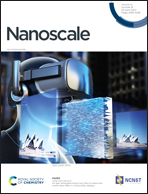Impact of covalent functionalization by diazonium chemistry on the electronic properties of graphene on SiC†
Abstract
Plenty of strategies focused on covalent interaction have been developed to functionalize graphene's surface in order to employ it in a wide range of applications. Among them, the use of radical species including nitrene, carbene and aryl diazonium salts is regarded as a promising strategy to establish the covalent functionalization of graphene. In this work, we highlight the effect of diazonium chemistry on the electronic properties of graphene on SiC. On the basis of X-ray and synchrotron-based photoemission experiments, we were able to prove that 3,4,5-trimethoxybenzenediazonium (TMeOD) units, reduced and chemisorbed onto graphene using electrochemistry, preserve the electronic structure of the Dirac cone, through inducing a slightly additional n-type doping of graphene, as revealed by a downshift of the Dirac cone probed by angle-resolved photoemission experiments.



 Please wait while we load your content...
Please wait while we load your content...